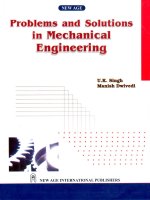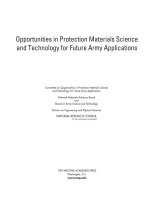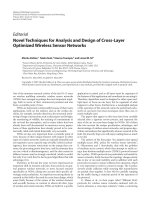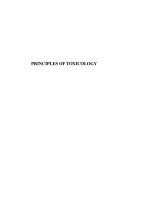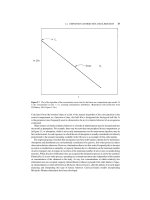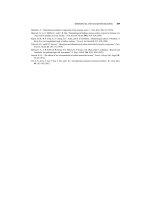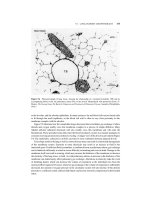industrial heating principles techniques materials applications and design dekker mechanical engineering
Bạn đang xem bản rút gọn của tài liệu. Xem và tải ngay bản đầy đủ của tài liệu tại đây (16.65 MB, 776 trang )
DK340X_half 3/31/05 2:05 PM Page 1
Industrial Heating
Principles, Techniques, Materials, Applications, and Design
© 2005 by Taylor & Francis Group, LLC
MECHANICAL ENGINEERING
A Series of Textbooks and Reference Books
Founding Editor
L. L. Faulkner
Columbus Division, Battelle Memorial Institute
and Department of Mechanical Engineering
The Ohio State University
Columbus, Ohio
1.
Spring Designer’s Handbook
, Harold Carlson
2.
Computer-Aided Graphics and Design
, Daniel L. Ryan
3.
Lubrication Fundamentals
, J. George Wills
4.
Solar Engineering for Domestic Buildings
, William A. Himmelman
5.
Applied Engineering Mechanics: Statics and Dynamics
, G. Boothroyd and
C. Poli
6.
Centrifugal Pump Clinic
, Igor J. Karassik
7.
Computer-Aided Kinetics for Machine Design
, Daniel L. Ryan
8.
Plastics Products Design Handbook, Part A: Materials and Components;
Part B: Processes and Design for Processes
, edited by Edward Miller
9.
Turbomachinery: Basic Theory and Applications
, Earl Logan, Jr.
10.
Vibrations of Shells and Plates
, Werner Soedel
11.
Flat and Corrugated Diaphragm Design Handbook
, Mario Di Giovanni
12.
Practical Stress Analysis in Engineering Design
, Alexander Blake
13.
An Introduction to the Design and Behavior of Bolted Joints
, John H. Bickford
14.
Optimal Engineering Design: Principles and Applications
, James N. Siddall
15.
Spring Manufacturing Handbook
, Harold Carlson
16.
Industrial Noise Control: Fundamentals and Applications
, edited by
Lewis H. Bell
17.
Gears and Their Vibration: A Basic Approach to Understanding Gear Noise
,
J. Derek Smith
18.
Chains for Power Transmission and Material Handling: Design and Applica-
tions Handbook
, American Chain Association
19.
Corrosion and Corrosion Protection Handbook
, edited by Philip A. Schweitzer
20.
Gear Drive Systems:
Design and Application
, Peter Lynwander
21.
Controlling In-Plant Airborne Contaminants: Systems Design and Calcula-
tions
, John D. Constance
22.
CAD/CAM Systems Planning and Implementation
, Charles S. Knox
23.
Probabilistic Engineering Design: Principles and Applications
,
James N. Siddall
24.
Traction Drives: Selection and Application
, Frederick W. Heilich III and
Eugene E. Shube
25.
Finite Element Methods: An Introduction
, Ronald L. Huston and
Chris E. Passerello
DK340X_FM.fm Page ii Wednesday, April 27, 2005 7:52 AM
© 2005 by Taylor & Francis Group, LLC
26.
Mechanical Fastening of Plastics: An Engineering Handbook
,
Brayton Lincoln, Kenneth J. Gomes, and James F. Braden
27.
Lubrication in Practice: Second Edition
, edited by W. S. Robertson
28.
Principles of Automated Drafting
, Daniel L. Ryan
29.
Practical Seal Design
, edited by Leonard J. Martini
30.
Engineering Documentation for CAD/CAM Applications
, Charles S. Knox
31.
Design Dimensioning with Computer Graphics Applications
, Jerome C. Lange
32.
Mechanism Analysis: Simplified Graphical and Analytical Techniques
,
Lyndon O. Barton
33.
CAD/CAM Systems: Justification, Implementation, Productivity Measure-
ment
, Edward J. Preston, George W. Crawford, and Mark E. Coticchia
34.
Steam Plant Calculations Manual
, V. Ganapathy
35.
Design Assurance for Engineers and Managers
, John A. Burgess
36.
Heat Transfer Fluids and Systems for Process and Energy Applications
,
Jasbir Singh
37.
Potential Flows: Computer Graphic Solutions
, Robert H. Kirchhoff
38.
Computer-Aided Graphics and Design: Second Edition
, Daniel L. Ryan
39.
Electronically Controlled Proportional Valves: Selection and Application
,
Michael J. Tonyan, edited by Tobi Goldoftas
40.
Pressure Gauge Handbook
, AMETEK, U.S. Gauge Division, edited by
Philip W. Harland
41.
Fabric Filtration for Combustion Sources: Fundamentals and Basic Technol-
ogy
, R. P. Donovan
42.
Design of Mechanical Joints
, Alexander Blake
43.
CAD/CAM Dictionary
, Edward J. Preston, George W. Crawford, and
Mark E. Coticchia
44.
Machinery Adhesives for Locking, Retaining, and Sealing
,
Girard S. Haviland
45.
Couplings and Joints: Design, Selection, and Application
, Jon R. Mancuso
46.
Shaft Alignment Handbook
, John Piotrowski
47.
BASIC Programs for Steam Plant Engineers: Boilers, Combustion, Fluid Flow,
and Heat Transfer
, V. Ganapathy
48.
Solving Mechanical Design Problems with Computer Graphics
,
Jerome C. Lange
49.
Plastics Gearing: Selection and Application
, Clifford E. Adams
50.
Clutches and Brakes: Design and Selection
, William C. Orthwein
51.
Transducers in Mechanical and Electronic Design
, Harry L. Trietley
52.
Metallurgical Applications of Shock-Wave and High-Strain-Rate Phenomena
,
edited by Lawrence E. Murr, Karl P. Staudhammer, and Marc A. Meyers
53.
Magnesium Products Design
, Robert S. Busk
54.
How to Integrate CAD/CAM Systems: Management and Technology
,
William D. Engelke
55.
Cam Design and Manufacture: Second Edition; with cam design software for
the IBM PC and compatibles
, disk included, Preben W. Jensen
56.
Solid-State AC Motor Controls: Selection and Application
, Sylvester Campbell
57.
Fundamentals of Robotics
, David D. Ardayfio
58.
Belt Selection and Application for Engineers
, edited by Wallace D. Erickson
59.
Developing Three-Dimensional CAD Software with the IBM PC
, C. Stan Wei
60.
Organizing Data for CIM Applications
, Charles S. Knox, with contributions
by Thomas C. Boos, Ross S. Culverhouse, and Paul F. Muchnicki
61.
Computer-Aided Simulation in Railway Dynamics
, by Rao V. Dukkipati and
Joseph R. Amyot
DK340X_FM.fm Page iii Wednesday, April 27, 2005 7:52 AM
© 2005 by Taylor & Francis Group, LLC
62.
Fiber-Reinforced Composites: Materials, Manufacturing, and Design
,
P. K. Mallick
63.
Photoelectric Sensors and Controls: Selection and Application
, Scott M. Juds
64.
Finite Element Analysis with Personal Computers
, Edward R. Champion, Jr.
and J. Michael Ensminger
65.
Ultrasonics: Fundamentals, Technology, Applications: Second Edition, Revised
and Expanded
, Dale Ensminger
66.
Applied Finite Element Modeling: Practical Problem Solving for Engineers
,
Jeffrey M. Steele
67.
Measurement and Instrumentation in Engineering: Principles and Basic Lab-
oratory Experiments
, Francis S. Tse and Ivan E. Morse
68.
Centrifugal Pump Clinic: Second Edition, Revised and Expanded
,
Igor J. Karassik
69.
Practical Stress Analysis in Engineering Design: Second Edition, Revised and
Expanded
, Alexander Blake
70.
An Introduction to the Design and Behavior of Bolted Joints: Second Edition,
Revised and Expanded
, John H. Bickford
71.
High Vacuum Technology: A Practical Guide
, Marsbed H. Hablanian
72.
Pressure Sensors: Selection and Application
, Duane Tandeske
73.
Zinc Handbook: Properties, Processing, and Use in Design
, Frank Porter
74.
Thermal Fatigue of Metals
, Andrzej Weronski and Tadeusz Hejwowski
75.
Classical and Modern Mechanisms for Engineers and Inventors
,
Preben W. Jensen
76.
Handbook of Electronic Package Design
, edited by Michael Pecht
77.
Shock-Wave and High-Strain-Rate Phenomena in Materials
, edited by
Marc A. Meyers, Lawrence E. Murr, and Karl P. Staudhammer
78.
Industrial Refrigeration: Principles, Design and Applications
, P. C. Koelet
79.
Applied Combustion
, Eugene L. Keating
80.
Engine Oils and
Automotive Lubrication
, edited by Wilfried J. Bartz
81.
Mechanism Analysis: Simplified and Graphical Techniques, Second Edition,
Revised and Expanded
, Lyndon O. Barton
82.
Fundamental Fluid Mechanics for the Practicing Engineer
, James W. Murdock
83.
Fiber-Reinforced Composites: Materials, Manufacturing, and Design, Second
Edition, Revised and Expanded
, P. K. Mallick
84.
Numerical Methods for Engineering Applications
, Edward R. Champion, Jr.
85.
Turbomachinery: Basic Theory and Applications, Second Edition, Revised and
Expanded
, Earl Logan, Jr.
86.
Vibrations of Shells and Plates: Second Edition, Revised and Expanded
,
Werner Soedel
87.
Steam Plant Calculations Manual: Second Edition, Revised and Expanded
,
V. Ganapathy
88.
Industrial Noise Control: Fundamentals and Applications, Second Edition,
Revised and Expanded
, Lewis H. Bell and Douglas H. Bell
89.
Finite Elements: Their Design and Performance
, Richard H. MacNeal
90.
Mechanical Properties of Polymers and Composites: Second Edition, Revised
and Expanded
, Lawrence E. Nielsen and Robert F. Landel
91.
Mechanical Wear Prediction and Prevention
, Raymond G. Bayer
92.
Mechanical Power Transmission Components
, edited by David W. South and
Jon R. Mancuso
93.
Handbook of Turbomachinery
, edited by Earl Logan, Jr.
DK340X_FM.fm Page iv Wednesday, April 27, 2005 7:52 AM
© 2005 by Taylor & Francis Group, LLC
94.
Engineering Documentation Control Practices and Procedures
,
Ray E. Monahan
95.
Refractory Linings Thermomechanical Design and Applications
,
Charles A. Schacht
96.
Geometric Dimensioning and Tolerancing: Applications and Techniques for
Use in Design, Manufacturing, and Inspection
, James D. Meadows
97.
An Introduction to the Design and Behavior of Bolted Joints: Third Edition,
Revised and Expanded
, John H. Bickford
98.
Shaft Alignment Handbook: Second Edition, Revised and Expanded
,
John Piotrowski
99.
Computer-Aided Design of Polymer-Matrix Composite Structures
, edited by
Suong Van Hoa
100.
Friction Science and Technology
, Peter J. Blau
101.
Introduction to Plastics and Composites: Mechanical Properties and Engineer-
ing Applications
, Edward Miller
102.
Practical Fracture Mechanics in Design
, Alexander Blake
103.
Pump Characteristics and Applications
, Michael W. Volk
104.
Optical Principles and Technology for Engineers
, James E. Stewart
105.
Optimizing the Shape of Mechanical Elements and Structures
, A. A. Seireg
and Jorge Rodriguez
106.
Kinematics and Dynamics of Machinery
, Vladimír Stejskal and
Michael Valásek
107.
Shaft Seals for Dynamic Applications
, Les Horve
108.
Reliability-Based Mechanical Design
, edited by Thomas A. Cruse
109.
Mechanical Fastening, Joining, and Assembly
, James A. Speck
110.
Turbomachinery Fluid Dynamics and Heat Transfer
, edited by Chunill Hah
111.
High-Vacuum Technology: A Practical Guide, Second Edition, Revised and
Expanded
, Marsbed H. Hablanian
112.
Geometric Dimensioning and
Tolerancing: Workbook and Answerbook
, James
D. Meadows
113.
Handbook of Materials Selection for Engineering Applications
, edited by
G. T. Murray
114.
Handbook of Thermoplastic Piping System Design
, Thomas Sixsmith and
Reinhard Hanselka
115.
Practical Guide to Finite Elements: A Solid Mechanics
Approach,
Steven M. Lepi
116.
Applied Computational Fluid Dynamics
, edited by Vijay K. Garg
117.
Fluid Sealing Technology
, Heinz K. Muller and Bernard S. Nau
118.
Friction and Lubrication in Mechanical Design
, A. A. Seireg
119.
Influence Functions and Matrices
, Yuri A. Melnikov
120.
Mechanical Analysis of Electronic Packaging Systems
, Stephen A. McKeown
121.
Couplings and Joints: Design, Selection, and Application, Second Edition,
Revised and Expanded
, Jon R. Mancuso
122.
Thermodynamics: Processes and Applications
, Earl Logan, Jr.
123.
Gear Noise and Vibration
, J. Derek Smith
124.
Practical Fluid Mechanics for Engineering Applications
, John J. Bloomer
125.
Handbook of Hydraulic Fluid Technology
, edited by George E. Totten
126.
Heat Exchanger Design Handbook
, T. Kuppan
127.
Designing for Product Sound Quality
, Richard H. Lyon
128.
Probability Applications in Mechanical Design
, Franklin E. Fisher and
Joy R. Fisher
DK340X_FM.fm Page v Wednesday, April 27, 2005 7:52 AM
© 2005 by Taylor & Francis Group, LLC
129.
Nickel Alloys
, edited by Ulrich Heubner
130. Rotating Machinery Vibration: Problem Analysis and Troubleshooting,
Maurice L. Adams, Jr.
131. Formulas for Dynamic Analysis, Ronald L. Huston and C. Q. Liu
132. Handbook of Machinery Dynamics, Lynn L. Faulkner and Earl Logan, Jr.
133. Rapid Prototyping Technology: Selection and Application, Kenneth G. Cooper
134. Reciprocating Machinery Dynamics: Design and Analysis,
Abdulla S. Rangwala
135. Maintenance Excellence: Optimizing Equipment Life-Cycle Decisions, edited
by John D. Campbell and Andrew K. S. Jardine
136. Practical Guide to Industrial Boiler Systems, Ralph L. Vandagriff
137. Lubrication Fundamentals: Second Edition, Revised and Expanded,
D. M. Pirro and A. A. Wessol
138. Mechanical Life Cycle Handbook: Good Environmental Design and Manufac-
turing, edited by Mahendra S. Hundal
139. Micromachining of Engineering Materials, edited by Joseph McGeough
140. Control Strategies for Dynamic Systems: Design and Implementation,
John H. Lumkes, Jr.
141. Practical Guide to Pressure Vessel Manufacturing, Sunil Pullarcot
142. Nondestructive Evaluation: Theory, Techniques, and Applications, edited by
Peter J. Shull
143. Diesel Engine Engineering: Thermodynamics, Dynamics, Design, and Control,
Andrei Makartchouk
144. Handbook of Machine Tool Analysis, Ioan D. Marinescu, Constantin Ispas,
and Dan Boboc
145. Implementing Concurrent Engineering in Small Companies,
Susan Carlson Skalak
146. Practical Guide to the Packaging of Electronics: Thermal and Mechanical
Design and Analysis, Ali Jamnia
147. Bearing Design in Machinery: Engineering Tribology and Lubrication,
Avraham Harnoy
148. Mechanical Reliability Improvement: Probability and Statistics for Experimen-
tal Testing, R. E. Little
149. Industrial Boilers and Heat Recovery Steam Generators: Design, Applications,
and Calculations, V. Ganapathy
150. The CAD Guidebook: A Basic Manual for Understanding and Improving Com-
puter-Aided Design, Stephen J. Schoonmaker
151. Industrial Noise Control and Acoustics, Randall F. Barron
152. Mechanical Properties of Engineered Materials, Wolé Soboyejo
153. Reliability Verification, Testing, and Analysis in Engineering Design,
Gary S. Wasserman
154. Fundamental Mechanics of Fluids: Third Edition, I. G. Currie
155. Intermediate Heat Transfer, Kau-Fui Vincent Wong
156. HVAC Water Chillers and Cooling Towers: Fundamentals, Application, and
Operation, Herbert
W. Stanford III
157. Gear Noise and Vibration: Second Edition, Revised and Expanded,
J. Derek Smith
158. Handbook of Turbomachinery: Second Edition, Revised and Expanded, edited
by Earl Logan, Jr. and Ramendra Roy
159. Piping and Pipeline Engineering: Design, Construction, Maintenance, Integ-
rity, and Repair, George A. Antaki
DK340X_FM.fm Page vi Wednesday, April 27, 2005 7:52 AM
© 2005 by Taylor & Francis Group, LLC
160. Turbomachinery: Design and Theory, Rama S. R. Gorla and Aijaz Ahmed Khan
161. Target Costing: Market-Driven Product Design, M. Bradford Clifton,
Henry M. B. Bird, Robert E. Albano, and Wesley P. Townsend
162. Fluidized Bed Combustion, Simeon N. Oka
163. Theory of Dimensioning: An Introduction to Parameterizing Geometric Models,
Vijay Srinivasan
164. Handbook of Mechanical Alloy Design, edited by George E. Totten, Lin Xie,
and Kiyoshi Funatani
165. Structural Analysis of Polymeric Composite Materials, Mark E. Tuttle
166. Modeling and Simulation for Material Selection and Mechanical Design,
edited by George E. Totten, Lin Xie, and Kiyoshi Funatani
167. Handbook of Pneumatic Conveying Engineering, David Mills, Mark G. Jones,
and Vijay K. Agarwal
168. Clutches and Brakes: Design and Selection, Second Edition,
William C. Orthwein
169. Fundamentals of Fluid Film Lubrication: Second Edition,
Bernard J. Hamrock, Steven R. Schmid, and Bo O. Jacobson
170. Handbook of Lead-Free Solder Technology for Microelectronic Assemblies,
edited by Karl J. Puttlitz and Kathleen A. Stalter
171. Vehicle Stability, Dean Karnopp
172. Mechanical Wear Fundamentals and Testing: Second Edition, Revised and
Expanded, Raymond G. Bayer
173. Liquid Pipeline Hydraulics, E. Shashi Menon
174. Solid Fuels Combustion and Gasification, Marcio L. de Souza-Santos
175. Mechanical Tolerance Stackup and Analysis, Bryan R. Fischer
176. Engineering Design for Wear, Raymond G. Bayer
177. Vibrations of Shells and Plates: Third Edition, Revised and Expanded,
Werner Soedel
178. Refractories Handbook, edited by Charles A. Schacht
179. Practical Engineering Failure Analysis, Hani M. Tawancy, Anwar Ul-Hamid,
and Nureddin M. Abbas
180. Mechanical Alloying and Milling, C. Suryanarayana
181. Mechanical Vibration: Analysis, Uncertainties, and Control, Second Edition,
Revised and Expanded, Haym Benaroya
182. Design of Automatic Machinery, Stephen J. Derby
183. Practical Fracture Mechanics in Design: Second Edition, Revised and
Expanded, Arun Shukla
184. Practical Guide to Designed Experiments, Paul D. Funkenbusch
185. Gigacycle Fatigue in Mechanical Practive, Claude Bathias and Paul C. Paris
186. Selection of Engineering Materials and Adhesives, Lawrence W. Fisher
187. Boundary Methods: Elements, Contours, and Nodes, Subrata Mukherjee and
Yu Xie Mukherjee
188. Rotordynamics, Agnieszka (Agnes) Muszn´yska
189. Pump Characteristics and
Applications: Second Edition, Michael W. Volk
190. Reliability Engineering: Probability Models and Maintenance Methods,
Joel A. Nachlas
191. Industrial Heating: Principles, Techniques, Materials, Applications, and
Design, Yeshvant V. Deshmukh
DK340X_FM.fm Page vii Wednesday, April 27, 2005 7:52 AM
© 2005 by Taylor & Francis Group, LLC
DK340X_title 4/11/05 10:18 AM Page 1
Industrial Heating
Principles, Techniques, Materials, Applications, and Design
Boca Raton London New York Singapore
A CRC title, part of the Taylor & Francis imprint, a member of the
Taylor & Francis Group, the academic division of T&F Informa plc.
Yeshvant V. Deshmukh
© 2005 by Taylor & Francis Group, LLC
Published in 2005 by
CRC Press
Taylor & Francis Group
6000 Broken Sound Parkway NW, Suite 300
Boca Raton, FL 33487-2742
© 2005 by Taylor & Francis Group, LLC
CRC Press is an imprint of Taylor & Francis Group
No claim to original U.S. Government works
Printed in the United States of America on acid-free paper
10987654321
International Standard Book Number-10: 0-8493-3405-5 (Hardcover)
International Standard Book Number-13: 978-0-8493-3405-4 (Hardcover)
Library of Congress Card Number 2004062059
This book contains information obtained from authentic and highly regarded sources. Reprinted material is
quoted with permission, and sources are indicated. A wide variety of references are listed. Reasonable efforts
have been made to publish reliable data and information, but the author and the publisher cannot assume
responsibility for the validity of all materials or for the consequences of their use.
No part of this book may be reprinted, reproduced, transmitted, or utilized in any form by any electronic,
mechanical, or other means, now known or hereafter invented, including photocopying, microfilming, and
recording, or in any information storage or retrieval system, without written permission from the publishers.
Danvers, MA 01923, 978-750-8400. CCC is a not-for-profit organization that provides licenses and registration
for a variety of users. For organizations that have been granted a photocopy license by the CCC, a separate
system of payment has been arranged.
Trademark Notice: Product or corporate names may be trademarks or registered trademarks, and are used only
for identification and explanation without intent to infringe.
Library of Congress Cataloging-in-Publication Data
Deshmukh, Yeshvant V.
Industrial heating : principles, techniques, materials, applications, and design / Yeshvant V.
Deshmukh.
p. cm.
Includes bibliographical references and index.
ISBN 0-8493-3405-5 (alk. paper)
1. Heating. 2. Furnaces. I. Title.
TH7121.D37 2004
621.402'2 dc22 2004062059
Visit the Taylor & Francis Web site at
and the CRC Press Web site at
Taylor & Francis Group
is the Academic Division of T&F Informa plc.
DK340X_Discl.fm Page 1 Thursday, April 21, 2005 10:31 AM
© 2005 by Taylor & Francis Group, LLC
( or contact the Copyright Clearance Center, Inc. (CCC) 222 Rosewood Drive,
For permission to photocopy or use material electronically from this work, please access www.copyright.com
Dedicated to
The memory of my Guru,
(Late) Prof. G.K. (Nana) Ogle
Formerly
The Principal and Head of Metallurgy
Department
College of Engineering—Pune, India
DK340X_FM.fm Page xi Wednesday, April 27, 2005 7:52 AM
© 2005 by Taylor & Francis Group, LLC
xiii
Contents
Preface xxiii
About the Author xxvii
Abstract xxix
Acknowledgments xxxi
Chapter 1 Introduction 1
1.1 In the Beginning 1
1.2 Heating System Classification 3
1.3 Classification of Heating Modes 7
1.4 Auxilliary Techniques 10
Chapter 2 Fluid Dynamics 13
2.1 Introduction 14
2.2 Sources of Gasses in Furnaces 14
2.3 Flow of Gases 15
2.4 Importance of Fluid Flow in Heating 17
2.5 Classification of Fluid Flow 18
2.6 Flow over Objects 21
2.7 Flow Separation 22
DK340X_FM.fm Page xiii Wednesday, April 27, 2005 7:52 AM
© 2005 by Taylor & Francis Group, LLC
xiv Industrial Heating
2.8 Forced Circulation in Enclosures 27
2.9 Use of Fans 29
2.10 Natural Gas Circulation inside Furnaces 29
2.11 Bernoulli’s Theorem of Fluid Flow 32
2.12 Frictional Losses in Flow 35
2.13 Local Losses 44
2.13.1 Common Local Features 46
2.13.2 Gas Flow through Ports 48
2.13.3 Pump Power 49
2.14 Stack Effect 51
2.15 Practical Flue System 53
Chapter 3 Steady State Heat Transfer 57
3.1 Introduction 58
3.2 Steady State Conduction 60
3.3 The Shape Factor 72
3.4 Graphical Method for Wall Heat Transfer
and Design 75
3.5 Convection 80
3.6 Forced Convection 85
3.6.1 Boundary Layer and Convection 86
3.6.2 Forced Convection over Flat Plate 88
3.6.3 Forced Convection inside Tubes 97
3.6.3A Laminar Flow 98
3.6.3B Turbulent Flow 99
3.6.4 Heat Transfer in Coils 108
3.7 Natural Convection (Flat Walls) 113
3.7.1 Free Convection over Horizontal Pipes 116
3.7.2 Free Convection inside Enclosures 121
3.8 Radiative Heat Transfer 124
3.9 Radiation Exchange between Bodies 128
3.9.1 Radiative Exchange between Two
Parallel Surfaces 129
3.9.2 Radiative Exchange between Article
and Enclosure 132
3.10 Radiation Screens 133
3.11 Radiation Exchange inside and outside
Furnaces 137
3.12 Radiation in Absorbing Media 140
3.13 Radiation Loss from Furnace Openings 146
3.14 Extended Surfaces 161
DK340X_FM.fm Page xiv Wednesday, April 27, 2005 7:52 AM
© 2005 by Taylor & Francis Group, LLC
Contents xv
Chapter 4 Transient Conduction 169
4.1 Introduction 170
4.2 Solution by Using Charts 171
4.3 Heating of Bodies of Finite Size 180
4.4 Transient Heating (Cooling) of a Semiinfinite Solid 189
4.4.1 Instantaneous Temperature Change at Surface. 189
4.4.2 Constant Radiation Flux 192
4.4.3 Surface Heating by Convection 192
4.4.4 The Late Regime 194
4.5 Transient Conduction—Finite Differences Method 199
4.6 Application of the Finite Difference Method
to a Multilayered Wall 205
4.7 Concentrated Heat Sources 211
4.7.1 Instantaneous Point Source 212
4.7.2 Continuous Sources 213
4.8 Transient Conduction Graphical Method
(Schmidt’s Method) 219
Chapter 5 Fuels and their Properties 225
5.1 Introduction 226
5.2 Properties of Fuels 226
5.3 Liquid Fuels 231
5.4 Gaseous Fuels 232
5.5 Biogas 233
5.5.1 Single Stage Generation 235
5.5.2 Two Stage Generator 236
5.6 Heating (Calorific) Value 238
5.7 Calculation of Calorific Value 240
5.8 Combustion Air Requirements and Products 243
5.8.1 Combustion Air and Practical Requirements. 245
5.8.2 Preheating of Air 246
5.9 Solid Waste and Garbage .247
5.10 Incomplete Combustion 249
5.11 Combustion and Pollution .252
Chapter 6 Fuel Burning Devices 275
6.1 Introduction 276
6.2 Combustion of Liquid Fuels 276
6.3 Classification of Oil Burners 280
6.3.1 High Pressure Burners 281
6.3.2 Low Pressure Burners 281
DK340X_FM.fm Page xv Wednesday, April 27, 2005 7:52 AM
© 2005 by Taylor & Francis Group, LLC
xvi Industrial Heating
6.4 Burners for Distillate Fuels 282
6.5 Preheating of Oils 284
6.6 Kinetics of Combustion of Gases 285
6.7 Burning Properties of Gases 287
6.8 Classification of Gas Burners 289
6.9 Flame Stabilization, Ignition,
and Detection 291
6.10 Atmospheric Gas Burners 293
6.11 Nozzle Mixing Gas Burners 296
6.12 Radiant Tubes 298
6.12.1 Immersion Tubes 300
6.13 Dual Fuel Burners 300
6.14 Packaged Burners 302
6.15 Combustion of Solid Waste and Garbage 303
6.16 Burner Auxilliaries 305
6.16.1 Burner Blocks 305
6.16.2 Ignition Devices 307
6.16.3 Flame Protection Devices 307
Chapter 7 Refractories 309
7.1 Introduction 310
7.2 Classification of Refractories 310
7.2.1 Fire Clay Refractories 311
7.2.2 High Alumina Refractories 312
7.2.3 Silica Refractories 313
7.2.4 Carbon and Graphite Refractories 313
7.2.5 Silicon Carbide (SiC) and Carborundum 314
7.2.6 Zircon Refractories 314
7.2.7 Zirconia Refractories 314
7.3 Insulating Refractories and Materials 315
7.4 Manufacture of Refractories 316
7.4.1 Raw Materials 316
7.5 Refractory Shapes 319
7.6 Unshaped Refractory Products 321
7.7 Refractory Fibers 322
7.8 Properties of Refractories 323
7.8.1 Room Temperature Properties 325
7.8.2 High Temperature Properties 326
7.9 Selection of Refractories 328
7.9.1 Thermal Requirements 328
7.9.2 Mechanical and Chemical
Requirements 332
DK340X_FM.fm Page xvi Wednesday, April 27, 2005 7:52 AM
© 2005 by Taylor & Francis Group, LLC
Contents xvii
Chapter 8 Metals and Alloys for High Temperature
Applications 333
8.1 Introduction 334
8.2 Mechanical Properties of Metals at High
Temperature 334
8.3 Oxidation and Corrosion 340
8.3.1 Corrosion by Other Gases 343
8.4 Melting Point and Physical Stability 345
8.5 Linear Expansion 346
8.6 Cast Irons 347
8.7 Steels at High Temperature 349
8.8 Selection of Metals for High Temperature Application 349
Chapter 9 Electric Resistance Heating 357
9.1 Introduction 358
9.2 Indirect Electrical Heating 358
9.2.1 Principles of Indirect Electric Heating 358
9.2.2 Material for Heaters 359
9.2.3 Special Insulating Materials in the
Construction of a Heater 361
9.3 Construction and Placement of Heaters 368
9.4 Design of Metallic Elements 373
9.4.1 Determination of Wire or Strip Size 377
9.5 Nonmetallic Heating Elements 383
9.5.1 Silicon Carbide Heating Elements 383
9.5.2 MoSi
2
Heating Elements 385
9.6 Design Calculations for Nonmetallic Elements 387
9.7 Direct Resistance (Conductive) Heating (DRH) 401
9.7.1 Principle of DRH 401
9.7.2 Design for DRH 403
9.7.3 Advantages and Limitations of DRH 405
9.8 Stored Energy Heating (SEH) 408
9.8.1 Principle of Stored Energy Heating 409
9.8.2 Practical Heating Circuit 411
9.8.3 Some Peculiarities of SEH 411
9.9 Salt Bath Furnaces 414
9.9.1 Introduction 414
9.9.2 Construction and Working
of Electrode Furnaces 415
9.9.3 Bath Salts 416
9.9.4 Some Peculiarities of Salt Baths 419
DK340X_FM.fm Page xvii Wednesday, April 27, 2005 7:52 AM
© 2005 by Taylor & Francis Group, LLC
xviii Industrial Heating
9.9.5 Applications of Salt Baths 419
9.9.6 Other Bath Furnaces 421
Chapter 10 High Frequency Heating 423
10.1 Induction Heating 424
10.1.1 Introduction 424
10.1.2 Principles of Induction Heating 425
10.1.3 Advantages and Disadvantages of
Induction Heating 425
10.1.4 Skin Effect 428
10.1.5 Ferrous and Nonferrous Heating 432
10.1.6 Choice of Frequency 433
10.1.7 High Frequency Generators 437
10.1.8 Mains Frequency Generators 437
10.1.9 Spark Gap Generators 438
10.1.10 Motor Generators 438
10.1.11 Solid State Generators 440
10.1.12 Some Features of Solid State Generators 442
10.1.13 Radio Frequency (RF) Power Generators 442
10.1.14 Features of RF Generators and Heating 444
10.1.15 Generator and Coil Matching 444
10.1.16 Thermal Requirements 447
10.1.17 Design of the Coil 449
10.1.18 Electrical Design of Coil 450
10.1.19 Equivalent Circuit Method of Coil Design 453
10.1.20 Physical Design of Coils 456
10.2 Dielectric Heating 466
10.2.1 Introduction 466
10.2.2 Principles of Dielectric Heating 466
10.2.3 Review of Related Electric Properties 466
10.2.4 Some Noteworthy Points About
Dielectric Heating 470
10.2.5 Applications of Dielectric Heating 471
10.3 Microwave Heating 472
10.3.1 Nature and Generation of Microwaves 472
10.3.2 Heat Generation by Microwaves 473
10.3.3 Heat Produced in Microwave Heating 477
10.3.4 Some Peculiarities of Microwave Heating 478
Chapter 11 Concentrated Heat Sources 485
11.1 Laser 488
11.1.1 Introduction 488
11.1.2 Generation of Laser Beam 489
DK340X_FM.fm Page xviii Wednesday, April 27, 2005 7:52 AM
© 2005 by Taylor & Francis Group, LLC
Contents xix
11.1.3 Noteworthy Points about Lasers 492
11.1.4 Limitations of Lasers 495
11.1.5 CO
2
Lasers 496
11.1.6 Nd-YAG Lasers 499
11.1.7 Ruby Lasers 501
11.1.8 Longitudinal Modes of Laser Beam 502
11.1.9 Focusing Properties of Lasers 504
11.1.10 Collimation 507
11.1.11 Coherence 508
11.1.12 Depth of Focus 508
11.1.13 Transverse Modes in Lasers 514
11.1.14 Temporal Characteristics of Lasers 515
11.1.15 Q Switching of the Laser Beam 517
11.1.16 Application of Lasers for Material Processing 520
11.1.17 Laser–Material Interaction 523
11.1.18 Reflectivity and Absorptivity 526
11.1.19 Laser Penetration 529
11.1.20 The Temperature Field 531
11.2 Electron Beam Heating 533
11.2.1 Introduction 533
11.2.2 Generation of Electron Beam 534
11.2.3 Characteristics of EB 537
11.2.4 EB—Noteworthy Points 538
11.2.5 EB—Material Interaction 539
11.2.6 Commercial EB Equipment 541
Chapter 12 Vacuum Engineering 543
12.1 Introduction 544
12.2 Units for Vacuum 545
12.3 Vacuum Pumps 546
12.3.1 Positive Displacement Pump 547
12.3.2 Roots Pump 550
12.3.3 Diffusion Pumps 554
12.3.4 Molecular Pumps 557
12.4 Pumping System Design 558
12.4.1 Selection of Vacuum Pumps 558
12.4.2 Calculation of Pumping Speed 562
12.5 Conductance and Pumping Speed 564
12.6 Baffles and Traps 568
12.7 Outgassing 569
12.8 Vacuum Pumping (Pressure–Time Relations) 574
12.9 Calculation of Pumping Time 587
DK340X_FM.fm Page xix Wednesday, April 27, 2005 7:52 AM
© 2005 by Taylor & Francis Group, LLC
xx Industrial Heating
12.10 Measurement of Vacuum 590
12.10.1 Mechanical Gauges 591
12.10.2 Conductivity Gauges 592
12.10.3 Ionization Gauge 594
Chapter 13 Protective Atmospheres 601
13.1 Introduction 602
13.2 Manufactured Atmosphere 603
13.3 Pure Gas Atmospheres 604
13.3.1 Nitrogen 604
13.3.2 Hydrogen 604
13.3.3 Helium and Argon 608
13.4 Heating of Protective Atmosphere Furnace 608
13.5 Determination of Atmosphere Consumption 610
13.5.1 Batch Type 611
13.5.2 Continuous Type 612
13.6 Instrumentation for Protective Atmospheres 624
13.6.1 Dew Point Measurement 624
13.6.2 Measurement of CO, CO
2
, CH
4
, and NH
3
627
13.6.3 Detection of Oxygen 628
13.6.4 Selection of Analytical Instruments 630
Chapter 14 Temperature Measurement 631
14.1 Introduction 632
14.2 Thermocouple Pyrometers 634
14.3 Property Requirements of Thermocouple Materials 636
14.4 Practical Thermocouples 637
14.5 Cold Junction Compensation 641
14.6 Compensating Wires 643
14.7 Construction of Thermocouples 643
14.8 Selection of Thermocouples 645
14.9 Radiation Pyrometry 647
14.9.1 Principle of Radiation 647
14.9.2 Practical Problems 649
14.10 Disappearing Filament Pyrometer 655
14.11 Radiation Pyrometers 657
14.11.1 Advantages of Radiation Pyrometers 661
14.11.2 Limitations 661
14.12 Miscellaneous Temperature-Related Devices 662
14.12.1 Temperature Indicating Colors 662
14.12.2 Bimetallic Devices 662
14.12.3 Bimetallic Energy Regulators 663
DK340X_FM.fm Page xx Wednesday, April 27, 2005 7:52 AM
© 2005 by Taylor & Francis Group, LLC
Contents xxi
14.12.4 Throwaway Tips 666
14.13 Temperature Indicators 666
14.14 Temperature Controllers 668
Chapter 15 Miscellany and Further 673
15.1 Introduction 674
15.2 Some Typical Furnaces 675
15.2.1 Rotating Hearth Furnace 675
15.2.2 Automatic Integral Quench Furnace 677
15.2.3 Vacuum Gas Furnace 680
15.2.4 Linear Continuous Furnaces 683
15.3 Incinerators 685
15.3.1 Large Scale Municipal Incinerator 687
15.3.2 Medium or Small Scale Incinerator 689
15.3.3 Domestic or Office Incinerator 689
15.4 Heat Exchangers 691
15.4.1 Classification of Heat Exchangers 693
15.4.2 Convective Heat Transfer over Tube Banks 699
15.4.3 Heat Exchanger Calculations 702
15.5 Drying Ovens 710
15.6 Baking Ovens 713
15.7 Fans 718
15.8 Some New Materials 723
15.8.1 Carbon Foams 723
15.8.2 Alumina Refractory Adhesive 723
15.8.3 Cast Basalt 724
Appendices
A. Pressure 725
B. Viscosity 729
C. Thermal Diffusivity 733
D. Humidity 737
E. Error Function 745
F. Properties of Air, Water, Gases 749
G. Emissivity 755
Bibliography 757
DK340X_FM.fm Page xxi Wednesday, April 27, 2005 7:52 AM
© 2005 by Taylor & Francis Group, LLC
xxiii
Preface
Heating is an integral part of many processes. It is used in diverse
processes such as heat treating, shaping, casting, moulding, and
joining fabrication, in one form or another. Food processing, drying,
waste disposal, desalining, and many other operations depend on
heating. The materials processed are metals, alloys, semiconductors,
polymers, textiles, farm products minerals, city and industrial gar-
bage, and so on. Each material and process requires heating meth-
ods suitable to its properties and the desired end products.
I came in contact with heating processes and the design field in
the early 1960s by chance. Since then the association has graduated
to consultation practice involving a wide range of heating problems.
Except a few books published in the 1950s, on furnace design for
mainly metallurgical industries, I found that there is no book on
general design techniques for heating. In the last half-century, there
have been substantial developments in heating techniques and
related materials. Laser, electron beam, and microwave heating;
fiber and fiber-based refractories; and powerful high vacuum pumps
are some of the notable advances, that were practically nonexistent
in the 1950s. The present book is an attempt to provide design
information on the traditional and modern heating processes and
auxiliary techniques.
DK340X_FM.fm Page xxiii Wednesday, April 27, 2005 7:52 AM
© 2005 by Taylor & Francis Group, LLC
xxiv Industrial Heating
The book is mainly aimed at designers engaged in the design
and manufacture of furnaces, laboratory apparatus, and material
processing equipment. It will also help the end users or buyers of
such equipment to formalize their requirements and arrive at spec-
ifications. Research workers can design and specify their experimen-
tal setups involving heating. As the coverage of heating processes
and allied techniques included in this book is very wide, almost all
industries will find it as a useful design guide and source book. It
will be advantageous if the reader has some basic knowledge of
physics, chemistry, and mathematics upto the under graduate level
in science or engineering.
The science of “heat transfer” is at the core of heating processes.
The analysis of related heat transfer and estimation of the effective
heat transfer coefficient is the first step toward a successful design.
The book opens with a review of selected topics in steady state and
transient heat transfer. A qualitative description of some topics in
fluid mechanics and aerodynamics is also included because of their
influence on heat transfer. Mathematical treatment is kept at the
minimum possible and more attention is given to concepts under-
lying the phenomenon. It is my experience that due to years of
separation from the academic field, the industrial community, in
general, is out of touch with the basic concepts; hence the need for
these reviews.
This is followed by fuels, their combustion and combustion
devices. Solid fuels are excluded as they are not used in small or
medium heating applications.
Garbage and waste incineration is treated in detail. I feel that
the growing problem of waste disposal in urban and industrial areas
all over the world is bound to make incineration on large scale a
necessity in future. All heating-process designers must have at least
a preliminary knowledge of incineration combustion and the prob-
lems with practical incinerators.
For the same reasons biogas generation and its combustion is
included with other traditional fuels.
Electricity as a “fuel” is used in industries on a large scale and
in many forms. All these forms are discussed in detail without going
deep into electrical engineering. Electric arc is not covered as it is
used in large-scale industries.
Auxilliary techniques related to heating, such as vacuum tech-
nology, pyrometry, protective atmosphere, and heat exchangers are
discussed in sufficient detail. Refractory, ceramic, and metallic
DK340X_FM.fm Page xxiv Wednesday, April 27, 2005 7:52 AM
© 2005 by Taylor & Francis Group, LLC
Preface xxv
materials used in the construction of furnaces are dealt with a view
to bring about their useful properties and limitations.
A large number of solved problems are included at each stage.
They should help the designer in understanding the underlying
principles. The appendices are meant mainly for clearing some basic
concepts which could not be included in the text. This need arises
from still continuing usage of diverse units. This book has used SI
units throughout.
The presentation of extensive data, about material properties,
in tabular form has been avoided. It is felt that selected data given
in various tables and figures should be sufficient for the preliminary
design. Abundant data in more precise numerical forms are avail-
able in almost all handbooks listed in the references. It is also
suggested that for problems involving graphical methods used in
transient heating, humidity etc., enlarged accurate graphs available
elsewhere should be referred for better precision. What are included
in text are reasonable outlines limited by resolution in reproduction.
All the design problems involved in the preliminary estimation
of heating can be satisfactorily solved by a hand held scientific
calculator. If a number of reiterations are called for, they can be
worked out on a computer. Many softwares are available for spe-
cialized areas in heat transfer but they are (almost) all dedicated
to particular situations. The designer is expected to have access to
computational facilities.
An interdisciplinary book of this type is never complete. It is
quite likely that some aspects of heating are either left out or not
sufficiently covered. I will be thankful to receive constructive sug-
gestions about any errors, omissions, and improvements to make
the book more useful.
A second volume is in the planning stage. It will open with a
discussion on the estimation of the heat transfer coefficient in prac-
tical situations followed by some typical construction features. The
major part will consist of a number of fully worked-out designs. Any
suggestions for inclusions in this volume will be highly appreciated.
Your comments may be directly communicated to me at the address
given below.
The preface will remain incomplete if I forget to mention my
wife Sumitra. She has been my counselor for all these years. The
book was a challenging job due to its complexity and my age. Her
constant support, encouragement, and help has made this task a
pleasure and fulfillment.
DK340X_FM.fm Page xxv Wednesday, April 27, 2005 7:52 AM
© 2005 by Taylor & Francis Group, LLC
xxvi Industrial Heating
Mangesh Limaye has converted my sketches to computer draw-
ings. He has also typed the manuscript. He has done both jobs with
great skill and patience.
I also take this opportunity to express my thanks to the staff
of Marcel Dekker for the design and organization; and Sam (Samik
Roy Chowdhury) and his staff at ITC (Ashish Bhatnagar, Bhavin-
der Singh, and Subir Saha) for editorial services and production
of the book.
Dr. Yeshvant V. Deshmukh
DK340X_FM.fm Page xxvi Wednesday, April 27, 2005 7:52 AM
© 2005 by Taylor & Francis Group, LLC
xxvii
About the Author
Dr. Yeshvant V. Deshmukh received graduateships in metallur-
gical and mechanical engineering from the Pune University. Subse-
quently, he received his doctorate in mechanical and production
engineering.
He has over forty years of combined experience in teaching,
research, and consultancy in engineering. He has taught undergrad-
uate and graduate classes in metallurgy and mechanical engineer-
ing at the Government Polytechnic, Pune and B.V. College of Engi-
neering, Pune where he was a professor and the chairperson of the
mechanical engineering department.
His consultancy was mainly in design of furnaces and heating,
heat treatment, and other processes.
He is an associate member of the Institution of Engineers (India)
and a Fellow of the Institute of the Mechanical Engineers (India).
He has written about 10 technical books and contributed extensively
to metallurgical and mechanical fields.
DK340X_FM.fm Page xxvii Wednesday, April 27, 2005 7:52 AM
© 2005 by Taylor & Francis Group, LLC
